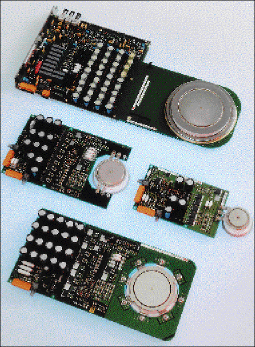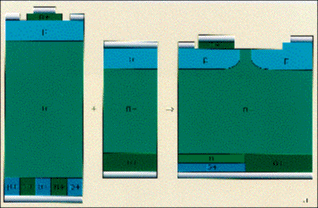Semiconductor technology has
IGBT and thyristor strengths
ABB Semiconductors (Pittsburgh, PA) has introduced a technology that
will, for the first time, enable easy cost-effective 10-MW switching at
medium-voltage levels. Combining the advantages of gate turn-off thyristors and insulated-gate bipolar transistors (IGBTs), integrated gate commutated
thyristors (IGCT) will allow a reduction in size and cost as well as an
improvement in efficiency and reliability of equipment needed to control
high-horsepower applications (see Fig. 1
).

Fig. 1. Capable of switching like IGBTs and conducting like
thyristors, IGCTs offer an improvement in efficiency and reliability
of equipment needed to control high-horsepower applications.
Unique in their ability to switch like an IGBT and conduct like a thyristor,
IGCTs are capable of operating at up to 1,000 Hz. This represents an improvement
of four times over previous power devices at full-rated current according
to the company.
At the core of ABB's gate commutated thyristor (GCT) switches is their
ability to allow thousands of individual monolithic elements on the wafer
to switch quickly and simultaneously. Also, they retain low on- and off-state
power losses that are inherent in thyristor designs.
To achieve these characteristics, the devices implement a transparent-anode
design (see Fig. 2 ). In addition, the thickness of the wafer is
reduced to limit the amount of stored charge, and the diode and switch
can be fabricated on the same wafer.

Fig. 2. Gate-commutated thyristors feature a transparent-anode design,
allowing for a thinner n-base layer and enabling the diode and switch to be
fabricated on the same wafer.
These features allow snubberless operation and low-inductance packaging
as well as eliminate the requirement for large complex inverter designs.
They also create the conditions required to reduce on-state switching losses
by 50% and switching losses by a factor of 2 to 2.5 at the device level.
In addition, because IGCTs have a thinner silicon wafer design and simplified
power circuitry, power electronic system costs can be reduced by a factor
of 30% or more and component count reduced by 50%. The first commercially
available IGCT–the 5SHY 35L4502–features a repetitive peak off-state
voltage of 4,500 V (V
GR
>= 2 V), a controllable turn-off
current of 4,000 A max (snubbered), and a maximum peak non-repetitive surge current of 25 kA. Threshold voltage is 1.10 V at on-state currents from
1,000 to 4,000 A.
The IGCT offers a 0.40-milliohm slope resistance at a 125°C junction
temperature and a cosmic radiation withstand design to provide a permanent
dc voltage of 2,800 V for a 100-FIT failure rate. It also offers direct
fiber-optic control, a turn-off time of less than 3 µs, and precise
timing (�t
don
The 5SHY 35L4502 has an overall measurement of 457 (L) x 40 (H) x 228
(W) mm. Other configurations and sizes are available as are three levels
of packaging and integration including a GCT press-pack semiconductor,
a GCT integrated into the gate unit, and IGCT application-ready stack or
valve.
Applications to immediately benefit from IGCTs include medium-voltage
drives, power-flow controllers, industrial rectifiers, power electronic
systems, and circuit breakers. The technology used to make the IGCT can
be scaled up or down to accommodate a wide range of applications. For more
information, call John Marous or John Siefken of ABB Semiconductors at
412-967-5858 or fax 412-967-5868.
Advertisement





